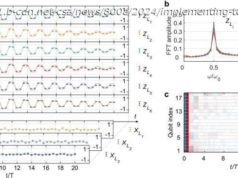No one really knows how the most advanced algorithms do what they do. That could be a problem.
L ast year, a strange self-driving car was released onto the quiet roads of Monmouth County, New Jersey. The experimental vehicle, developed by researchers at the chip maker Nvidia, didn’t look different from other autonomous cars, but it was unlike anything demonstrated by Google, Tesla, or General Motors, and it showed the rising power of artificial intelligence. The car didn’t follow a single instruction provided by an engineer or programmer. Instead, it relied entirely on an algorithm that had taught itself to drive by watching a human do it.
Getting a car to drive this way was an impressive feat. But it’s also a bit unsettling, since it isn’t completely clear how the car makes its decisions. Information from the vehicle’s sensors goes straight into a huge network of artificial neurons that process the data and then deliver the commands required to operate the steering wheel, the brakes, and other systems. The result seems to match the responses you’d expect from a human driver. But what if one day it did something unexpected—crashed into a tree, or sat at a green light? As things stand now, it might be difficult to find out why. The system is so complicated that even the engineers who designed it may struggle to isolate the reason for any single action. And you can’t ask it: there is no obvious way to design such a system so that it could always explain why it did what it did.
The mysterious mind of this vehicle points to a looming issue with artificial intelligence. The car’s underlying AI technology, known as deep learning, has proved very powerful at solving problems in recent years, and it has been widely deployed for tasks like image captioning, voice recognition, and language translation. There is now hope that the same techniques will be able to diagnose deadly diseases, make million-dollar trading decisions, and do countless other things to transform whole industries.
But this won’t happen—or shouldn’t happen—unless we find ways of making techniques like deep learning more understandable to their creators and accountable to their users. Otherwise it will be hard to predict when failures might occur—and it’s inevitable they will. That’s one reason Nvidia’s car is still experimental.
Already, mathematical models are being used to help determine who makes parole, who’s approved for a loan, and who gets hired for a job. If you could get access to these mathematical models, it would be possible to understand their reasoning. But banks, the military, employers, and others are now turning their attention to more complex machine-learning approaches that could make automated decision-making altogether inscrutable. Deep learning, the most common of these approaches, represents a fundamentally different way to program computers. “It is a problem that is already relevant, and it’s going to be much more relevant in the future,” says Tommi Jaakkola, a professor at MIT who works on applications of machine learning. “Whether it’s an investment decision, a medical decision, or maybe a military decision, you don’t want to just rely on a ‘black box’ method.”
There’s already an argument that being able to interrogate an AI system about how it reached its conclusions is a fundamental legal right. Starting in the summer of 2018, the European Union may require that companies be able to give users an explanation for decisions that automated systems reach. This might be impossible, even for systems that seem relatively simple on the surface, such as the apps and websites that use deep learning to serve ads or recommend songs. The computers that run those services have programmed themselves, and they have done it in ways we cannot understand. Even the engineers who build these apps cannot fully explain their behavior.
This raises mind-boggling questions. As the technology advances, we might soon cross some threshold beyond which using AI requires a leap of faith. Sure, we humans can’t always truly explain our thought processes either—but we find ways to intuitively trust and gauge people. Will that also be possible with machines that think and make decisions differently from the way a human would? We’ve never before built machines that operate in ways their creators don’t understand. How well can we expect to communicate—and get along with—intelligent machines that could be unpredictable and inscrutable? These questions took me on a journey to the bleeding edge of research on AI algorithms, from Google to Apple and many places in between, including a meeting with one of the great philosophers of our time.
In 2015, a research group at Mount Sinai Hospital in New York was inspired to apply deep learning to the hospital’s vast database of patient records. This data set features hundreds of variables on patients, drawn from their test results, doctor visits, and so on. The resulting program, which the researchers named Deep Patient, was trained using data from about 700,000 individuals, and when tested on new records, it proved incredibly good at predicting disease. Without any expert instruction, Deep Patient had discovered patterns hidden in the hospital data that seemed to indicate when people were on the way to a wide range of ailments, including cancer of the liver. There are a lot of methods that are “pretty good” at predicting disease from a patient’s records, says Joel Dudley, who leads the Mount Sinai team. But, he adds, “this was just way better.”
At the same time, Deep Patient is a bit puzzling. It appears to anticipate the onset of psychiatric disorders like schizophrenia surprisingly well. But since schizophrenia is notoriously difficult for physicians to predict, Dudley wondered how this was possible. He still doesn’t know. The new tool offers no clue as to how it does this. If something like Deep Patient is actually going to help doctors, it will ideally give them the rationale for its prediction, to reassure them that it is accurate and to justify, say, a change in the drugs someone is being prescribed. “We can build these models,” Dudley says ruefully, “but we don’t know how they work.”
Artificial intelligence hasn’t always been this way. From the outset, there were two schools of thought regarding how understandable, or explainable, AI ought to be. Many thought it made the most sense to build machines that reasoned according to rules and logic, making their inner workings transparent to anyone who cared to examine some code.






